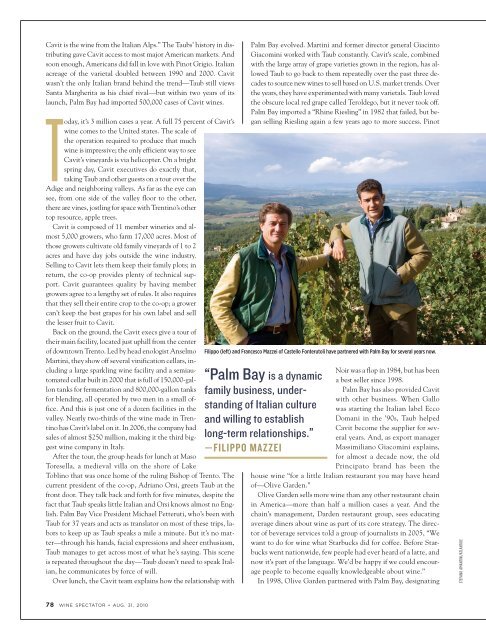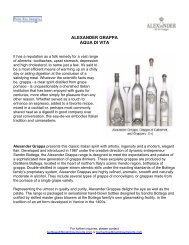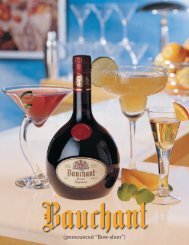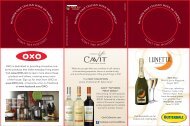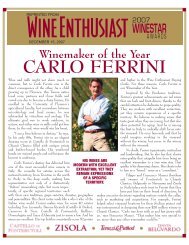Create successful ePaper yourself
Turn your PDF publications into a flip-book with our unique Google optimized e-Paper software.
Cavit is the wine from the Italian Alps.” The Taubs’ history in distributing<br />
gave Cavit access to most major American markets. And<br />
soon enough, Americans did fall in love with Pinot Grigio. Italian<br />
acreage of the varietal doubled between 1990 and 2000. Cavit<br />
wasn’t the only Italian brand behind the trend—Taub still views<br />
Santa Margherita as his chief rival—but within two years of its<br />
launch, <strong>Palm</strong> <strong>Bay</strong> had imported 500,000 cases of Cavit wines.<br />
Today, it’s 3 million cases a year. A full 75 percent of Cavit’s<br />
wine comes to the United states. The scale of<br />
the operation required to produce that much<br />
wine is impressive; the only efficient way to see<br />
Cavit’s vineyards is via helicopter. On a bright<br />
spring day, Cavit executives do exactly that,<br />
taking Taub and other guests on a tour over the<br />
Adige and neighboring valleys. As far as the eye can<br />
see, from one side of the valley floor to the other,<br />
there are vines, jostling for space with Trentino’s other<br />
top resource, apple trees.<br />
Cavit is composed of 11 member wineries and almost<br />
5,000 growers, who farm 17,000 acres. Most of<br />
those growers cultivate old family vineyards of 1 to 2<br />
acres and have day jobs outside the wine industry.<br />
Selling to Cavit lets them keep their family plots; in<br />
return, the co-op provides plenty of technical support.<br />
Cavit guarantees quality by having member<br />
growers agree to a lengthy set of rules. It also requires<br />
that they sell their entire crop to the co-op; a grower<br />
can’t keep the best grapes for his own label and sell<br />
the lesser fruit to Cavit.<br />
Back on the ground, the Cavit execs give a tour of<br />
their main facility, located just uphill from the center<br />
of downtown Trento. Led by head enologist Anselmo<br />
Martini, they show off several vinification cellars, including<br />
a large sparkling wine facility and a semiautomated<br />
cellar built in 2000 that is full of 150,000-gallon<br />
tanks for fermentation and 800,000-gallon tanks<br />
for blending, all operated by two men in a small office.<br />
And this is just one of a dozen facilities in the<br />
valley. Nearly two-thirds of the wine made in Trentino<br />
has Cavit’s label on it. In 2006, the company had<br />
sales of almost $250 million, making it the third biggest<br />
wine company in Italy.<br />
After the tour, the group heads for lunch at Maso<br />
Toresella, a medieval villa on the shore of Lake<br />
Toblino that was once home of the ruling Bishop of Trento. The<br />
current president of the co-op, Adriano Orsi, greets Taub at the<br />
front door. They talk back and forth for five minutes, despite the<br />
fact that Taub speaks little Italian and Orsi knows almost no English.<br />
<strong>Palm</strong> <strong>Bay</strong> Vice President Michael Petteruti, who’s been with<br />
Taub for 37 years and acts as translator on most of these trips, labors<br />
to keep up as Taub speaks a mile a minute. But it’s no matter—through<br />
his hands, facial expressions and sheer enthusiasm,<br />
Taub manages to get across most of what he’s saying. This scene<br />
is repeated throughout the day—Taub doesn’t need to speak Italian,<br />
he communicates by force of will.<br />
Over lunch, the Cavit team explains how the relationship with<br />
<strong>Palm</strong> <strong>Bay</strong> evolved. Martini and former director general Giacinto<br />
Giacomini worked with Taub constantly. Cavit’s scale, combined<br />
with the large array of grape varieties grown in the region, has allowed<br />
Taub to go back to them repeatedly over the past three decades<br />
to source new wines to sell based on U.S. market trends. Over<br />
the years, they have experimented with many varietals. Taub loved<br />
the obscure local red grape called Teroldego, but it never took off.<br />
<strong>Palm</strong> <strong>Bay</strong> imported a “Rhine Riesling” in 1982 that failed, but began<br />
selling Riesling again a few years ago to more success. Pinot<br />
Filippo (left) and Francesco Mazzei of Castello Fonterutoli have partnered with <strong>Palm</strong> <strong>Bay</strong> for several years now.<br />
“<strong>Palm</strong> <strong>Bay</strong> is a dynamic<br />
family business, understanding<br />
of Italian culture<br />
and willing to establish<br />
long-term relationships.”<br />
—Filippo mazzei<br />
Noir was a flop in 1984, but has been<br />
a best seller since 1998.<br />
<strong>Palm</strong> <strong>Bay</strong> has also provided Cavit<br />
with other business. When Gallo<br />
was starting the Italian label Ecco<br />
Domani in the ’90s, Taub helped<br />
Cavit become the supplier for several<br />
years. And, as export manager<br />
Massimiliano Giacomini explains,<br />
for almost a decade now, the old<br />
Principato brand has been the<br />
house wine “for a little Italian restaurant you may have heard<br />
of—Olive Garden.”<br />
Olive Garden sells more wine than any other restaurant chain<br />
in America—more than half a million cases a year. And the<br />
chain’s management, Darden restaurant group, sees educating<br />
average diners about wine as part of its core strategy. The director<br />
of beverage services told a group of journalists in 2005, “We<br />
want to do for wine what Starbucks did for coffee. Before Starbucks<br />
went nationwide, few people had ever heard of a latte, and<br />
now it’s part of the language. We’d be happy if we could encourage<br />
people to become equally knowledgeable about wine.”<br />
In 1998, Olive Garden partnered with <strong>Palm</strong> <strong>Bay</strong>, designating<br />
stefano amantini/atlantide<br />
78 Wine Spectator • Aug. 31, 2010


